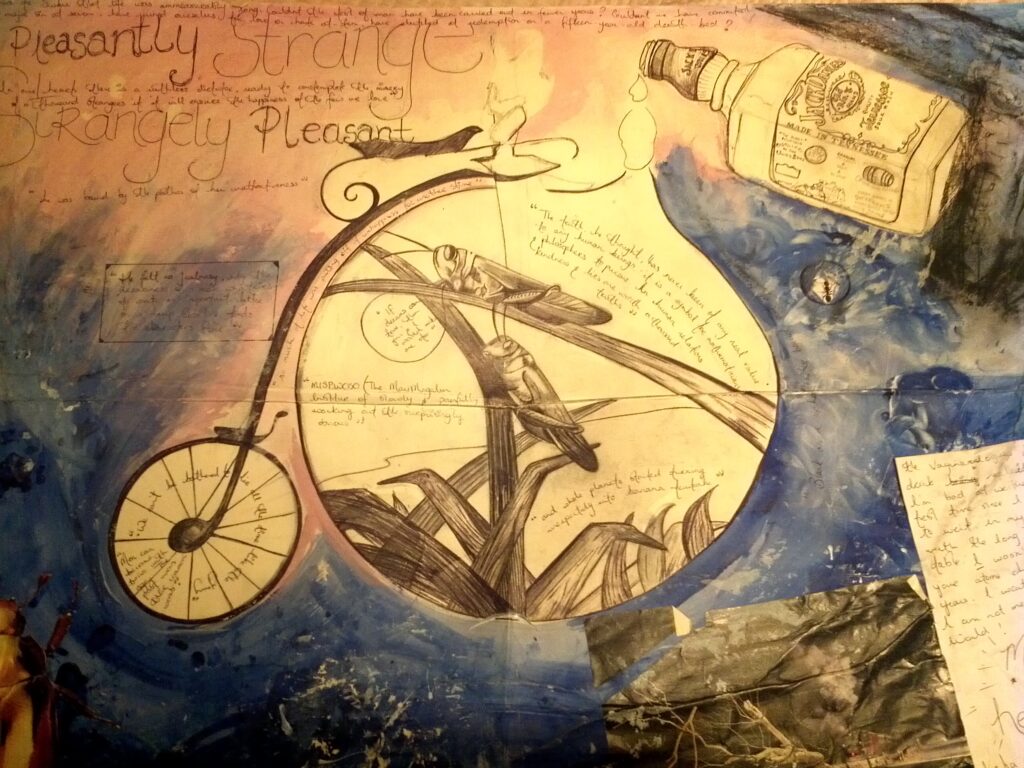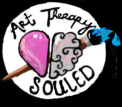my philosophy
“When the brain is whole, the unified consciousness of the left and right hemispheres adds up to more than the individual properties of the separate hemispheres”.
-Roger W Sperry
Consciousness is dual in nature but our society, to its detriment, values only one type (ordinary, ego consciousness). ArtTherapySouled therefore works to promote non ordinary states of consciousness such as the creative state of flow, the dream and the psychedelic state. This healing approach is two pronged. Firstly the inner healing intelligence or soul that emerges in these states highlights the areas of psychic energy that need releasing. Once these blockages have been released through catharsis, we begin to lessen the egos grip over our conscious experience. Once this is done we are capable of evolving our consciousness, moving on to what some term higher or cosmic consciousness or even the kingdom within.
This is an approach based on both scientific and sprititual approaches.

Scientific approach
The idea that an imbalance in consciousness could lead to the end of civilization is described by psychiatrist, Ian McGilchrist in his book; ‘The Master and his Emissary : the divided brain and the making of the Western world’. McGilchrist describes how the left and right brain work as two very distinct operating systems which result in two very different experiences of reality, almost as if we have two persons in our head (the soul and the ego). McGilchrist proposes that our civilization is at risk of collapse because it has become too bureaucratic, too mechanistic, too rational or too left brained. In other words we spend too much time in ordinary consciousness, which is the only form of consciousness our society values.
“Our talent for division, for seeing the parts, is of staggering importance – second only to our capacity to transcend it, in order to see the whole. These gifts of the left hemisphere have helped us achieve nothing less than civilisation itself, with all that that means. Even if we could abandon them, which of course we can’t, we would be fools to do so, and would come off infinitely the poorer. There are siren voices that call us to do exactly that, certainly to abandon clarity and precision (which, in any case, importantly depend on both hemispheres), and I want to emphasise that I am passionately opposed to them. We need the ability to make fine discriminations, and to use reason appropriately. But these contributions need to be made in the service of something else, that only the right hemisphere can bring. Alone they are destructive. And right now they may be bringing us close to forfeiting the civilisation they helped to create.”
What McGilchrist says we need is the right brain of the therapist talking to the right brain of the client, which art therapy is perfect for. The left brain needs to be in service to the right, like the proper relationship of the master and the emissary referenced in his title.
The belief that non-ordinary states of consciousness can be healing is central to the life’s work of Czech psychiatrist Stanislav Grof. Grof came to his conclusions largely thanks to his professional studies with LSD. These studies, conducted in the 1950 & 60’s before the suppression of LSD research, led the psychoanalytically trained Grof to conclude that there was a certain sub type of non ordinary states which were crucial to psychological growth and healing. He termed these states ‘holotropic’, meaning moving toward wholeness. Holotropic states of consciousness include meditative, mystical or psychedelic states. I propose the creative state of flow, should be added to the list.
Grof believes that in NOSC there is an inner guide (the soul if you will) which scans the system and brings to light any latent symptoms or areas where psychic energy may be blocked. This methodology brings the role of the therapist back to it’s original Greek meaning ‘to attend’.
corper mattis, pulvinar dapibus leo.
The current renaissance in psychedelic research, after a moratorium of more than 4o years, is providing scientific support for the hypothesis that non ordinary states of consciousness can be healing. For example Roseman, Nutt & Carhart-Harris (2018) found that measures of oceanic boundlessness which is correlated with mystical states of consciousness; was predictive of the effectiveness of psilocybin when used to treat depression.
The idea also makes sense in light of the discovery that an overactive Default Mode Network, which has been proposed as the biological counterpart of the ego, is overactive in depression.
My ideas were also influenced by the work of Dr. Andrew Weil, specifically his book ‘The natural mind’ in which he argues that the desire to alter ones state of consciousness is an innate, normal, human drive. A view shared by the well known psychiatrist/author Oliver Sacks who also saw that as humans we have a need to transcend our ordinary everyday experience; “that make our consciousness of time and morality easier to bear”.
.
Spirituality
The art therapist Shaun McNiff highlights the fact that art therapy is not a new discipline but rather the most recent expression of ancient shamanic practices. Shamanic practices involve contacting the spirit world through altered or non ordinary states of consciousness, bringing this spiritual energy into our world to gain wisdom or for healing purposes. A key feature of shamanism is the belief in the sacred, an acceptance of the fact that forces exist outside of our (or rather our ego’s) control that influence our lives.
The psychologist James Hillman lamented the fact that “the core subject of psychology, psyche or soul, doesn’t get into the books supposedly dedicated to its study and care”. Hillman proposed what he called the ‘acorn theory’ of development, the idea that each of “bears a uniqueness that asks to be lived and that is already present before it can be lived” . This belief as he points out is based on an old idea, and comes from Plato’s Myth of Er, the idea that each of us comes to the world called. As explained by Plotinus (A.D. 205-270), each of us chose the body, place and circumstances we were born into, those which the soul required to live out its fate. Our soul knows who we are from the beginning, just as the whole oak tree is contained in the acorn. So in order to be aware of the direction our lives should be going in, we simply need to foster soul or non ego states of consciousness.
Ordinary consciousness is totally wrapped up in words, in thoughts. The ego identifies and separates itself from the rest of the world by labelling. Eckhart Tolle describes the duality of consciousness in terms of thinking and awareness. “In the background, there is awareness. In the foreground, there is the voice, the thinker. In this way you are becoming free of the ego, free of the unobserved mind. The moment you become aware of the ego in you, it is strictly speaking no longer the ego but just an old, conditioned mind-pattern. For Tolle spiritual awakening means becoming free of identification with form, freedom from the ego.
Sam Harris echoes this point in his book, “A guide to spirituality without religion”, where he considers the essence of spirituality to be “repeatedly cutting through the illusion of the self”.
In ‘The Kingdom Within’ the Jungian analyst John A. Sanford interprets Jesus’s message in terms of consciousness. He describes how Christianity is not a mystical religion which would advocate for a dissolving of the ego and a merging with the godhead but rather psychological one as it calls for the completion of the individual personality. The idea that in order to become psychologically whole we need to evolve past ego consciousness.
Sanford also proposes the idea that the kingdom of heaven is actually an “inner spiritual reality”, cosmic consciousness in other words. Which he describes as leading us “beyond our individual eg0-existence to an experience with a transcendent source of life…the unfolding of a Self that predates and transcend the ego”.
When discussing sin, Sanford points out that it is the ego that is prone to sin and that this sin is comes from unconsciously motivated actions. the original Greek term used in the bible was ‘amartia’. Literally meaning; to ‘miss the mark’. “Sin springs from a state of moral darkness brought on by a lack of awareness, that causes one to miss the mark”.
Escaping the grip of the ego and realizing our true place as part of nature, is a common theme of the work of Alan Watts. Watts was famous as an interpreter of Eastern thought and highlights the similarity between Eastern philosophy and the practice of Western psychotherapy.
He believed that what drove people to seek Buddhist enlightenment is the same reason people seek therapy; an over identification with the ego. People seek help because they believe that they are suffering, and the point of psychotherapy/Buddhist training is to realize that the you you think is suffering, is an illusion.
We do not wish to get rid of the ego completely, it is a necessary part of our experience here. What we want to do is to realize that is not who we are. The ego is the space suit our soul wearss to anchor itself in the present, to give time its direction. It is a tool.
Accepting this, we cease to be so strongly identified with the ego, with our thoughts. We no longer live caught up in the endless chattering of the ego. ‘The monkey mind” We don’t need to be always thinking, planning, because its not all up to us. we are part of nature and just as the acorn unfurls into an oak tree, we learn to let our life follow its course. Forces exists outside of our control. This acceptance brings about a change in consciousness because our awareness is more often in the present, in our bodies, in the moment. This is the sacredness, the peace which is missing from our modern lives.
“One must be able to let things happen. I have learnt from the East what is meant by the phrase Wu-Wei; namely, ‘not doing, letting be” which is quite different from doing nothing”
-Jung

